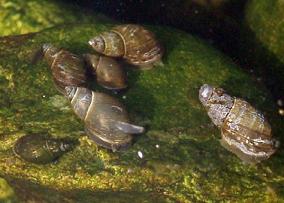Nutrition
 The genus Stagnicola has been observed feeding on
natural vegetation including algae, Elodea which is a
genus of aquatic plants also know as waterweeds, buttercup, and
water cress. While Bovbjerg was doing research in the Iowa Lakeside
Laboratory, snails in the genus Stagnicola, were feed
lettuce and liver, which they seemed to enjoy (Bovbjerg, 1965).
The genus Stagnicola has been observed feeding on
natural vegetation including algae, Elodea which is a
genus of aquatic plants also know as waterweeds, buttercup, and
water cress. While Bovbjerg was doing research in the Iowa Lakeside
Laboratory, snails in the genus Stagnicola, were feed
lettuce and liver, which they seemed to enjoy (Bovbjerg, 1965).
Some close relatives of the Stagnicola elodes include
Stagnicola reflexia, Stagnicola palustris, and
Lymnaea stagnalis. In Iowa, Bovbjerg observed that Stagnicola palustris showed preference for lettuce,
spinach, bacteria and algae in the laboratory(Bovbjerg, 1965). In addition, a
preference was confirmed noting Stagniola reflexia
feeding on algae rather than vascular plants. The Lymnaea
stagnalis has been described to feed on living and dead
pond weeds and blanket algae(Bovbjerg, 1965).
Whereas Stagnicola elodes
is said to be a plant eater, carnivore, and scavenger (Bovbjerg, 1965).
Snails in general do not move very much, usually only to find
food and reproduce. Locomotion is by the muscular foot, and is
described as gliding, hunching, ascent or descent.
Stagnicola species are relatively large and can move fairly
quick, one meter within a half hour. The species move through
sand, gravel, mud, dirt, and vegetation (Bovbjerg, 1965). The chemoreceptor cells
are located on the anterior end of the foot and assist the snail
in finding food. However, studies by Bovbjerg, showed that the snails'
locomotion was random and undirected (Bovbjerg, 1965). The Stagnicola
reflexia seemed to move until it encountered favorable
feeding grounds, where it would slow and feed. If it did not
encounter optimal feeding areas, the snail continued to wander.
This evidence showed that many species of Stagnicola,
including Stagnicola elodes, wander in search of food (Bovbjerg, 1965).